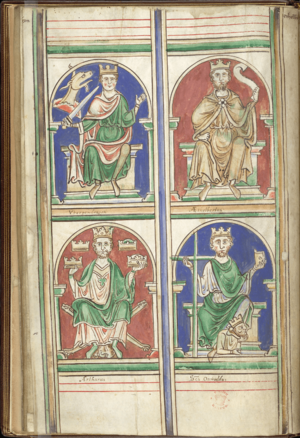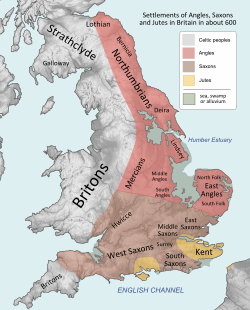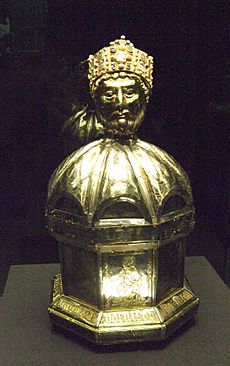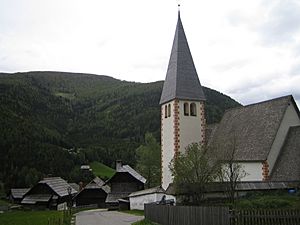Oswald of Northumbria facts for kids
Quick facts for kids Oswald |
|
|---|---|

A 12th-century painting of St Oswald in Durham Cathedral
|
|
| Bretwalda | |
| Reign | 633–642 |
| Predecessor | Edwin of Northumbria |
| Successor | Oswiu |
| King of Deira | |
| Reign | 633–642 |
| Predecessor | Osric of Deira |
| Successor | Oswiu |
| King of Bernicia | |
| Reign | 634-642 |
| Predecessor | Eanfrith of Bernicia |
| Successor | Oswiu |
| Born | c. 604 Deira, Northumbria |
| Died | 5 August 641/42 (approximately 37 years old) |
| Spouse | Kyneburga of Wessex |
| Issue | Œthelwald of Deira |
| Religion | Christianity |
Oswald (born around 604 – died August 5, 641 or 642) was a powerful king in early England. He ruled the kingdom of Northumbria from 634 until his death. Oswald is also known as a saint and was greatly admired during the Middle Ages.
He was the son of Æthelfrith, who was the king of Bernicia. Oswald became king after spending some time living away from his home. He defeated a Welsh ruler named Cadwallon ap Cadfan. After this victory, Oswald brought the two parts of Northumbria, Bernicia and Deira, back together under one ruler. He also helped spread Christianity across Northumbria.
A historian named Bede wrote about Oswald less than a century after he died. Bede thought Oswald was a very saintly king. Most of what we know about Oswald today comes from Bede's writings. Oswald ruled for eight years and was the most powerful ruler in Britain. He was killed in the Battle of Maserfield while fighting against Penda of Mercia, another powerful king. Oswald's brother, Oswiu, later defeated Penda.
Contents
Early Life and Time in Exile
Oswald's father, Æthelfrith, was a successful king from Bernicia. He also became king of Deira, uniting these two kingdoms for the first time. However, people at this time still saw themselves as Bernicians or Deirans, not as one "Northumbrian" group. Oswald's mother, Acha of Deira, was from the royal family of Deira. Æthelfrith likely married her to help him take control of Deira. Oswald was probably born around the year 604. Bede says he died at age 38 in 642, which fits this birth year.
Æthelfrith was a strong military leader, especially against the native British people. But he was killed in battle around 616 by Raedwald of East Anglia. This defeat meant that Edwin, a relative of Oswald's mother, became king of Northumbria. Because of this, Oswald and his brothers had to leave their home.
Oswald spent the rest of his youth in Dál Riata, a Scottish kingdom in northern Britain. While there, he became a Christian. He might have also fought in Ireland during this time away from home. Some believe Oswald is one of three Saxon princes mentioned in an old Irish poem called Togail Bruidne Dá Derga. In the poem, he is called 'Osalt'.
Victory Over Cadwallon

In 633, Cadwallon ap Cadfan, the king of Gwynedd in Wales, joined forces with the pagan king Penda of Mercia. They defeated and killed King Edwin of Northumbria in the Battle of Hatfield Chase. After this, Northumbria split back into its two kingdoms, Bernicia and Deira.
Oswald's brother, Eanfrith, became king of Bernicia. But Cadwallon killed him in 634 after Eanfrith tried to make peace. After this, Oswald led a small army. He may have had help from allies in the north, like the Scots or the Picts. Oswald's army met Cadwallon's forces in battle at Heavenfield, near Hexham.
Before the battle, it is said that Oswald set up a wooden cross. He knelt and held the cross in place while his soldiers packed earth around it to make it stand firm. Then he prayed and asked his army to pray with him.
A writer named Adomnán wrote a longer story about this. He said that Oswald told his vision to his council. Everyone agreed they would become Christian after the battle. In the fight that followed, the Welsh army was completely defeated, even though they had more soldiers. Cadwallon himself was killed.
Oswald's Rule and Power

After his victory at Heavenfield, Oswald brought Northumbria back together. He made Bernicia the leading kingdom again, just as it had been before Edwin's rule. Bede, the historian, said that Oswald held imperium (meaning he had great power) for the eight years he ruled. Both Bede and the Anglo-Saxon Chronicle say Oswald's reign was considered nine years long. This is because they counted the year before his rule, when others ruled who were not Christian. In the 9th century, the Anglo-Saxon Chronicle called him a Bretwalda, which means a powerful ruler over other kings in Britain. Adomnán even called Oswald "Emperor of all Britain."
It seems Oswald was widely recognized as a powerful overlord, though we don't know exactly how much control he had. Bede claimed that Oswald "brought under his dominion all the nations and provinces of Britain." Bede noted that Britain was divided by language among the English, Britons, Scots, and Picts. However, Bede also said that Oswald's brother, Oswiu, later made the Picts and Scots pay tribute. An Irish record, the Annals of Tigernach, says that Anglo-Saxons united against Oswald early in his rule. This might mean they tried to end his power south of the Humber River, but they likely failed.
The Mercians, who helped defeat Edwin in 633, seemed to challenge Oswald's power south of the Humber. However, it's generally thought that Oswald had some control over Mercia after Heavenfield. It might have been to please Oswald that Penda killed Eadfrith, Edwin's captured son. Eadfrith was a rival to Oswald's family.
Oswald also seemed to control the Kingdom of Lindsey. Bede tells a story about Oswald's bones being moved to a monastery there. The monks at first didn't want the bones because Oswald had ruled over them as a foreign king.
Oswald had good relations with the West Saxons. He was present when their king, Cynegils, was baptized. Oswald also married Cynegils' daughter. Only one source, a 12th-century book, names her as Kyneburga. Oswald had one known son, Æthelwald. It's not clear if Æthelwald was the son of Kyneburga or from an earlier relationship. Since Æthelwald started ruling in Deira in 651, some think he might have been too young if he was Kyneburga's son. This suggests he might have been older, perhaps born during Oswald's time in exile.
Spreading Christianity
Although Edwin had become a Christian in 627, Oswald did the most to spread the religion in Northumbria. Soon after becoming king, he asked the Irish from Dál Riata to send a bishop. This bishop would help convert his people. The Irish first sent a very strict bishop who was not successful. So, they sent Aidan, who suggested a gentler way.
Oswald gave the island of Lindisfarne to Aidan to be his main church base. Aidan was very successful in spreading the Christian faith. Bede wrote that Oswald acted as Aidan's interpreter when Aidan was preaching. This was because Aidan didn't know English well, and Oswald had learned Irish during his exile.
Bede focused on Oswald being a saintly king during his life, not just because of his death. Bede never actually used the word "martyr" for Oswald. This was unusual, as kings were often seen as saints if they gave up their rule for religious life or died in a special way. Bede wrote about Oswald's kindness to the poor and to strangers. He told a story to show this: One Easter, Oswald was having dinner with Aidan. He had "a silver dish full of dainties" in front of him. A servant, who Oswald had chosen to help the poor, came in. The servant told Oswald that many poor people were outside asking for help.
According to Bede, Oswald immediately gave his food to the poor. He even had the silver dish broken up and given to them. Aidan was very impressed. He grabbed Oswald's right hand and said, "May this hand never perish." Bede reported that Oswald's hand and arm remained uncorrupted (meaning they did not decay) after his death.
Oswald's Final Battle
A conflict with the pagan Mercians, led by King Penda, led to Oswald's downfall. He was killed in 642 by the Mercians at the Battle of Maserfield. This battle likely took place in Oswestry, though other locations have been suggested. Bede wrote that Oswald "ended his life in prayer." He prayed for the souls of his soldiers when he knew he was about to die.
The traditional location of the battle, Oswestry, was probably in the territory of Powys at the time. This suggests that Penda might have had British allies in this battle. Some old Welsh poems also hint that men from Powys fought in the battle. If Oswestry is the correct location, it means Oswald was attacking his enemies in their own territory. This might go against Bede's saintly image of Oswald, as an aggressive war might not be seen as a "just war." This could explain why Bede doesn't say why the war started. He only says Oswald died "fighting for his fatherland."
Oswald might have had an ally in Penda's brother, Eowa. Eowa was also killed in the battle. Some historians think Eowa might have been under Oswald's rule and fighting alongside him against Penda.
Legacy and Veneration
| Saint Oswald of Northumbria |
|
|---|---|
| Martyr | |
| Born | c. 604 Deira, Northumbria |
| Died | 5 August 641/642 |
| Venerated in | The Roman Catholic Church, The Anglican Communion, Eastern Orthodoxy |
| Canonized | Pre-Congregation |
| Major shrine | Bardney Abbey, Lincolnshire, England; relics later translated to St Oswald's Priory, Gloucester, England |
| Feast | 5 August |
| Attributes | king in crown, carrying sceptre and orb, ciborium, sword, palm-branch, and/or with his raven |

Oswald quickly came to be seen as a saint. Bede wrote that the place where he died became known for miracles. People would take dirt from the site, creating a hole as deep as a person's height. Another writer, Reginald of Durham, told a story about a bird (perhaps a raven) taking Oswald's right arm to an ash tree. This made the tree stay green forever. When the bird dropped the arm, a spring appeared from the ground. Both the tree and the spring were later linked to healing miracles. Some parts of these stories might have influences from older pagan beliefs. The name of the battle site, Oswestry, means "Oswald's Tree." This name is thought to come from Oswald's death there and the legends around it. His feast day is August 5. People even honored him in parts of Europe, like in Ožbalt, Slovenia.
Bede mentioned that Oswald's brother, Oswiu, who became king after him, found Oswald's remains the year after his death. Bede also wrote about a miracle linked to Oswald that showed how he was seen in lands he had conquered. Years later, Oswald's niece, Osthryth, moved his bones to Bardney Abbey in Lindsey. At first, the monks there refused to accept them. Even though they knew he was a holy man, they didn't want his bones. This was because "he was originally of another province, and had reigned over them as a foreign king." They still disliked him, even after his death.
Only after a wonderful miracle did they accept the bones. During the night, a pillar of light appeared over the wagon carrying the bones. It shone up into the sky. The next morning, the monks who had refused the bones now eagerly prayed for them to be placed in their monastery.
In the early 900s, Bardney was in Viking territory. In 909, after a raid by West Saxons and Mercians, led by Æthelflæd (daughter of Alfred the Great), St Oswald's bones were moved. They went to a new church in Gloucester, which was renamed St Oswald's Priory in his honor. Æthelflæd and her husband were buried there. Her nephew, King Æthelstan, was a big supporter of Oswald's cult.

Oswald's head was buried in Durham Cathedral. It was placed with the remains of Cuthbert of Lindisfarne, another saint. People believe his head is still there, though some other places in Europe also claim to have it. One of his arms is said to have ended up in Peterborough Abbey later in the Middle Ages. The story says that monks from Peterborough secretly took Oswald's uncorrupted arm from Bamburgh. They brought it back to Peterborough and built a special chapel for it, called Oswald's Chapel. This chapel can still be seen today. The monks even built a narrow tower in the chapel, just big enough for a monk to stand guard over the arm 24 hours a day.
Many churches are named after St Oswald. This includes The Church of Saint Oswald at the place where Oswald left the wooden cross before the battle. This church was rebuilt in 1717. St Oswald's Grasmere is said to be where he preached. The grave of the famous poet William Wordsworth is in its cemetery. St Oswald's Church, Compton Abdale in Gloucestershire, was dedicated to him after Æthelflæd founded St Oswald's Priory. There is also St Oswald's Catholic Church north of Peterborough City Centre.
Some English place names also remember his reign. For example, Oswaldtwistle in Lancashire is thought to be linked to the saint, though it might just be named after a land owner. Kirkoswald in Cumbria is named because people believe his body was taken there after his death. The local church is dedicated to him. Another Kirkoswald in Scotland also remembers him.
The Church of England remembers Oswald with a special day, a Lesser Festival, on August 5.
See also
 In Spanish: Oswaldo de Bernicia para niños
In Spanish: Oswaldo de Bernicia para niños


